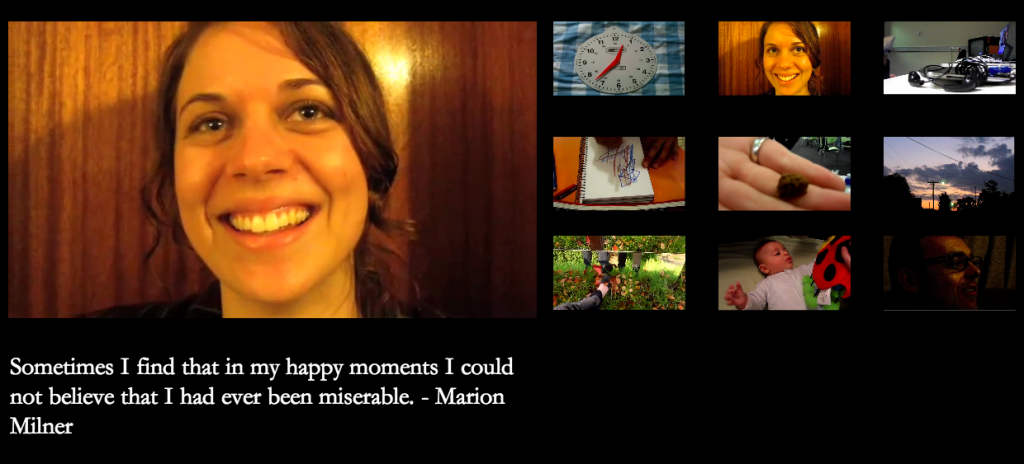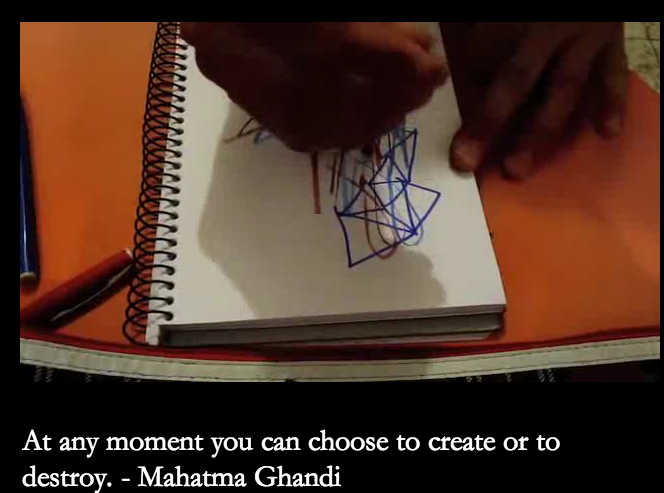Film Essay: BEST SPENT, 2010
Makers: Jess O’Farrell, Ruby Jones and Ezra Silman.
Available at: http://vogmae.net.au/classworks/2010/BestSpent.html
Best Spent is a work organised into nine rotating thumbnails set out in a 3×3 layout that link to a corresponding video. The videos include a piece of text that takes the form of a popular saying or quote (Image1). These help contextualise each clip in their own right as well as provides a link to the work’s overarching theme of Time, the way it could best be spent and the way it is spent.

Some clips reflect the idea of the way time is best spent such as for example the piano playing clip with the text “Practise makes perfect” added. However most of the content seems to refer more to how time comes to be spent rather than how it is best spent. It poses questions about the activities that fill our time: our habits, procrastination, leisure activities, educational obligations, mundane chores, eating habits and set routines.
As an audience and participant the title of “Best spent” places a weight on the proverbial shoulders. It creates a sort of wariness of time, it’s passing and the choices made in filling this constantly passing time. It made me personally conscious of the fact that I was spending time analysing a piece about passing time and made me think (with some concern) about how much time I spend doing what I want versus the time I spend doing what I feel obligated to do.
The opening clip’s text and corresponding video is a quote by Gandhi on the choice we all have at any given moment “to create or to destroy” (Image2)

The pattern that follows this is that each clip relates to an obligatory action (perhaps a destruction of ‘time best spent’) or a chosen action (perhaps a creation of ‘time best spent’. The clips shift back and forth from the everyday and mundane activities of doing the washing and brushing teeth to the more animated such as playing games, practicing the keyboard and talking to a friend on the phone. Then there are the “in-between” videos that seem to exist in a suspended time. These are the videos on procrastination and even the ones spoken “to camera” (Image 3), The to-camera pieces have a journaling quality that transports the viewer to the subject’s present—like time travel. I don’t know if that was the intended feel but it was a pleasant one.

The interface is simple and the vast collection of quotes and phrases alongside the stationary 3×3 catalogue of clips contributes to the voluminous feel of the work. Nine stationary thumbnails (from a rotating collection) are available to the audience at all times. The thumbnails and their corresponding clips exists as mini films in their own rights that “tell” their own story of choices and actions undertaken in time. The relates to Ernst’s view that narrative sequences exist as facts in their own right and are interwoven into a contextual reality. The contextual reality here is the nature of spending time and how vast and varied this “spending is”.
The choice to click on the most aesthetically pleasing of the rotating nine thumbnails is always available. This interface helps to develop the pattern of “choice” where the viewer/participant is actively choosing what activity they would like to witness next. This in turn corresponds with the role of choice within the theme of Time. While the use of the quotes helps contextualise each individual clip, not all of the clips include text or a quote. This feels like a downfall in the piece or a break in the pattern. In the absence of a piece of text, some clips seem quite “lost”.
Narration is an interesting element in this piece. There is no set narration or narrator through the entirety of the piece. However a handful of clips do have a speaking character. At times these characters speak absent minded, unaware of the camera and at others, the deliberately speak of the creation of the work itself. The latter seems to create a sense of realness as it forms a relation with the audience directly as they understand and process the spoken words as well as opposed to simply interpreting the quote-clip combination available with most of the other clips. It was these clips that engaged me the most.
The work reads like a list—an informal cataloguing of a day’s activities. Bogost’s view of listing as a practical way of reading and understanding content certainly applies here, especially as the activities listed in the collection of clips are commonplace to the viewers as well as creators. The content has a tone of familiarity to it.
All together, the work reads as a categorical narrative as the information presented is without a point of argument or persuasion. It simply “is”. It is a documentary on how time is spent and it is a simple non-linear narrative that portrays just that.